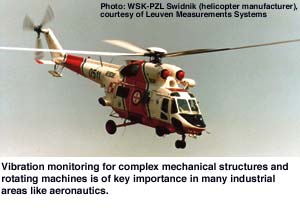In-operation Modal Analysis and Vibration Monitoring
by Michèle Basseville
Sharp monitoring of the vibrations of mechanical structures and rotating machines, under ambient excitation and in-operation, can be achieved through an appropriate multi-sensor signal processing, based on both system theoretic and statistical methods.

In-operation vibration monitoring for complex mechanical structures and rotating machines is of key importance in many industrial areas: aeronautics (wings and other structures subject to strength), automobile (gearbox mounting with a sports car body), rail transportation, power engineering (rotating machines, core and pipes of nuclear power plants), civil engineering (large buildings subject to hurricanes or earthquakes, bridges, dams, offshore structures). Tools for the detection and the diagnosis of small changes in vibratory characteristics are particularly useful to set up a preventive maintenance policy based on the actual evolution of the state of the monitored machine or structure, as opposed to systematic a priori planning
Classical modal analysis and vibration monitoring methods for mechanical structures and rotating machines are basically concerned with processing measurements made either on testbeds, or under specific excitation or rotation speed conditions.
The object of the Eureka project ‘SINOPSYS’ (model based Structural monitoring using IN-OPeration SYStem identification), which is co-ordinated by LMS (Leuven Measurements Systems, Leuven, Belgium), is to develop and integrate modal analysis and vibration monitoring software devoted to the processing of measurements recorded during routine operation, without artificial excitation, nor slow down, nor shut down of the machine. Two INRIA research teams participate in SINOPSYS: Sigma2 (in co-operation with CNRS) and META2.
The main contribution of INRIA to SINOPSYS consists in an original set of algorithms for multi-sensor signal processing (eg accelerometer measure-ments) that produces intelligent warnings, that is to say warnings that reveal the hidden causes of the defects or damage undergone by the machine or structure. This software can be embedded and work online. Among the actual data that INRIA has to process with the software developed within SINOPSYS are the Ariane 5 test flight data.
The first step of the SINOPSYS project has been focussed on modal analysis and identification of modeshapes. The key issue is to identify the eigenstructure (eigenvalues and observed components of eigenvectors) of the state transition matrix of a linear dynamical system. This can be deduced from the observability matrix of the system, written in the modal basis. A well-known key property is the fact that this observablity matrix and the empirical Hankel matrix do have the same left kernel. Therefore, subspace methods, based on the singular value decomposition of the empirical Hankel matrix, are good candidates for modal analysis, and have been used. They have been extended to the joint processing of measurements recorded by different sensor pools. Interactive methods for the selection and the validation of the modes have also been developed.
The second step of SINOPSYS has been the development of a tool for fatigue detection, that also evaluates the importance, for each mode, of the modal deviation which is detected. The detection algorithm is based on both the above mentioned left kernel space property and a local approach relying on a central limit theorem. This detection test can be equally used for laboratory test beds with measured excitation, and for in-operation data without measuring the excitation.
The third step is the development of a tool for diagnosing the fatigues, where the goal is to explain the fatigues in terms of modifications of volumic mass or Young modulus, and to localize those modifications on the structure or machine.
For the two first steps (identification and modal test), a Scilab toolbox will be available with the next release. These monitoring and diagnosis algorithms have been generalized to models more complex than those for vibrations, and can be used for monitoring in industrial process control (gas turbine, electric or thermal plant) or for on board diagnosis (catalytic exhaust).
Links:
SINOPSYS: http://www.irisa.fr/sigma2/sinopsys
Please contact:
Michèle Basseville
Tel: +33 2 99 84 72 36
E-mail: Michele.Basseville@irisa.fr
